
The smallest radio system I have is Dynamics Unlimited RFFS 100. It consists of two actuator servos and a receiver with built in speed controller. Each actuator consists of a coil of wire and a magnet. The coil and magnet combined weigh 1 gram. The receiver weighs 1.9 grams, so the total weight of the entire system is just 3.9 grams. This is a fully proportional three channel system (not bang-bang) on a 72MHz frequency. This system is available from Dynamics Unlimited and American Fun Fly (see my Links Page).
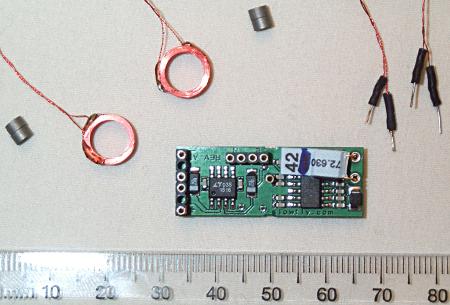
The RFFS 100 system, two actuators (magnets and coils) (above left),
the receiver/speed controller (lower middle) and the actuator plugs.
(Reference in mm)
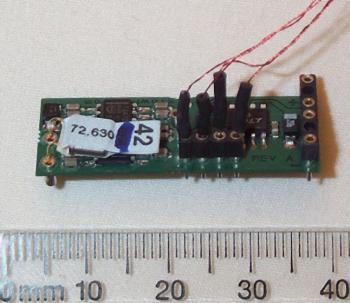
Here is a close up of the actuators plugged into the receiver board.
(Again, reference in mm)
All the receivers (Rxs) I use in my planes are multi channel fully proportional FM Rxs that work with my Futaba and Hitec transmitters. I have a few different Rxs that I use in my micro planes.
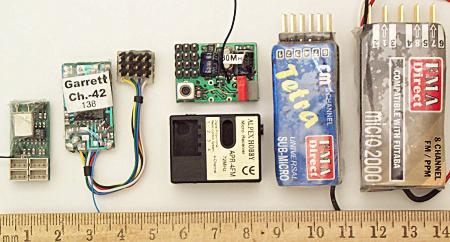
From left to right, Sky Hooks & Rigging's RX72, the Garrett,
Alpex APR-4FM, FMA Tetra and FMA Micro 2000 micro Rxs.
| Channels | Mode | Frequency (MHz) | Weight g (oz) | Price (US$) | |
| RV-RX72 | 4 | FM | 72 | 2.7 (0.10) | 98 |
| Garrett | 4 | FM | 72 non-narrowband | 4.4 (0.15) | 90 |
| APR-4FM | 4 | FM | 72 non-narrowband | 5.7 (0.20) | 30 |
| Tetra | 6 | FM | 50/53/72 | 14.9 (0.53) | 85 |
| Micro 2000 | 6 | FM | 72 | 22.1 (0.78) | discontinued |
The smallest Rx I have is the Sky Hooks & Rigging's RX72. It is a four channel Rx and weighs only 2.7 (0.095oz). The version I have has JST style connectors (the ones you see on most of the European gear), there is also a version available with Futaba type connectors and one without any connectors which is said to weigh a mere 1.7g!
The next smallest Rx that I have is a design by Paul Garrett. It is a four channel Rx and weighs 4.4g (0.15oz). It comes with Futaba style connectors which are on a block that is separate from the main Rx board. If you get rid of the connector block and solder the leads directly to your servos and ESC you can get the weight down to 3.5g.
Probably one of the best deals for small receivers are the APR-4FM (although GWS now has some nice low priced Rxs as well). There are FM, 72 MHz, 4 Channel, and weigh 5.7g (0.2oz) without case, and 8.8g with the case (mine actually both weigh 5.5g without their cases). The Rxs sell for only $30.
Two of my other small Rxs are from FMA Direct, the Micro 2000 and the Tetra. Both of these Rxs have 6 channels. The Micro 2000 weighs 22.1g (0.78oz) and the Tetra weighs 14.9g (0.53oz). The Micro 2000 has been discontinued, but has been replace by the Fortress, which is lighter and available in both AM and FM.
I have a number different types of servos that are suitable for my planes. Below is a picture and table comparing the different servos.
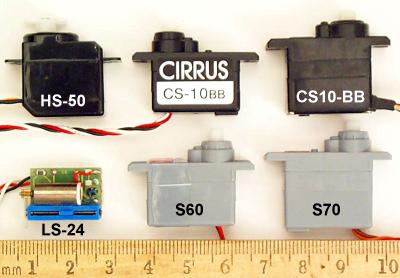
| Servo: | LS-24 | HS-50 | S60 | CS10-BB | S70 | CS20-BB |
| Wt g (oz): | 2.9 (0.10) | 5.8 (0.20) | 6.0 (0.21) | 6.2 (0.22) | 7.1 (0.25) | 9.0 (0.32) |
| Cost (US$): | 65 | 30 | 30 | 27 | 30 | 18 |
I currently have five different electronic speed controllers (ESC) I use in my planes: Castle Creations Pixie-Lite and Pixie-7, JMP's Type 7, a Bob Selman's BSSC2 and FMA's mini 5. Here they all are together to see their relative sizes.
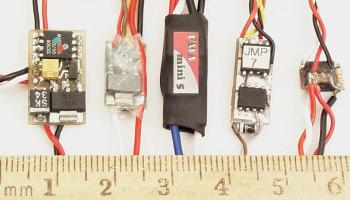
The Pixie-Lite, Pixie-7, the mini 5,
the Type 7, the BSSC2 (left to right).
Castle Creations Pixie-Lite
 |
I max: 14 Amps Voltage: 3.5-19.2 V BEC: yes Auto cutoff: yes (3.5V) Weight: 2.3 (0.08oz) Price: $45 |
Pros: Will work with a 3 cell NiCd pack with out any modifications. When the servos are activated the motor does not slow down much, if at all. Cons: Does not work with a 3V Li battery even with modifications to disable BEC and auto cutoff. |
|
|
Comments: This is a nice little ESC. It has a very wide range of applications. You can use it with very small 3 cell planes, or if you put heavier wire on it you can use it with Speed 400 planes. |
|||
Castle Creations Pixie-7
|
I max: 7 Amps Voltage: 3.5-19.2 V BEC: yes Auto cutoff: yes (3.5V) Weight: 2.3g (0.08oz) Price: $45 |
Pros: Will work with a 3 cell NiCd pack with out any modifications. When the servos are activated the motor does not slow down much, if at all. Cons: Does not work with a 3V Li battery even with modifications to disable BEC and auto cutoff. |
||
|
Comments: This is a nice little ESC. It has a very wide range of applications. You can use it with very small 3 cell planes, or if you put heavier wire on it you can use it with Speed 400 planes. |
|||
FMA mini 5
|
I max: 5 Amps Voltage: 6.0-9.6 V BEC: yes Auto cutoff: no Weight: 2.4g (0.09oz) Price:$20 |
Pros: When the servos are activated the motor does not slow down much, if at all. Each one is tested by FMA before they ship it. Cons: 6 V minimum voltage. Mine weighed 0.23 oz (6.4g) out of the package, and not the advertised 0.09 oz. The weight can probably be brought down considerably though, by removing the heat shrink and putting smaller and shorter leads on it, the Rx lead that it comes with is about 8 inches long, much longer than it needs to be. |
||
|
Comments: I have just received this ESC so I haven't done much testing with it yet. So far it appears to be a great value. |
|||
JMP Type 7
|
I max: 4 Amps Voltage: 6-10.8 V BEC: yes Auto cutoff: yes, soft Weight: 2.1g (0.07oz) Price:$56 |
Pros: This was one of the first micro ESCs to hit the scene, and continues to prove it is a great ESC. Cons: 6 V minimum voltage. As the batteries start to drain a little the motor slows or cuts out when the servos are activated. |
||
|
Comments: This was the first of the tiny ESCs that I purchased, and one of first ones developed and made available to the public on a larger scale. ESCs like this one helped convince the US RC distributors that there was a demand for very small ESCs here in the states. |
|||
Bob Selman BSSC2
|
I max: 4 Amps Voltage: 2.7-5.5 V BEC: not needed Auto cutoff: no Weight: 1.6g (0.07oz) Price:$25 |
Pros: 2.7 V minimum voltage. Will work with a 3 V Li battery. When the servos are activated the motor does not slow down much, if at all. Cons: 5.5 V maximum voltage (for low voltage use only). |
||
|
Comments: This is the smallest ESC that I have. I use it in my smallest planes which have 3 cell packs as the power source, so the 5.5 V max voltage is not a problem. Bob Selman is a great guy to do business with. |
|||
I have converted some of my lightest gear to JST style connectors. Before I converted them they had Futaba compatible connectors. I managed to shave a gram or two off the total weight by switching to the JST connectors. Below are photos are the two of the smaller sets of gear that I have on top of my digital balance. The lighter set weighs 26.4g (0.93oz) and consists of two LS-24 servos, a KP00 propulsion system with a U-80 prop, a 3-cell 50mAh NiCd battery pack, Sky Hooks and Rigging's RV-RX72 receiver and Bob Selman's BSSC2 ESC. The other weighs 27.1g (0.96oz) and consists of the same gear, except it has a Pixie-Lite ESC instead of the BSSC2.
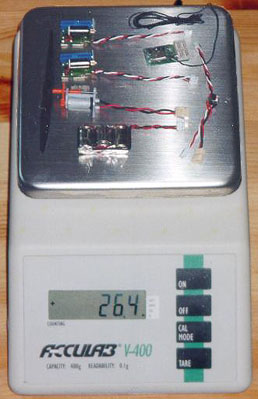
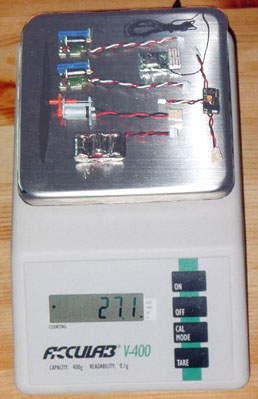
Below is a table that shows a number of different combinations of radio gear and motors with their total weights that I am using or planning on using in my planes:
| Rx | Servos | Batteries | ESC | Motor | Wt g (oz) | Plane |
| Tetra | 2 HS-50 | 4-cell 110mah | 54.4 (1.9) | My next glider | ||
| Micro 2000 | 2 CS20-BB | 4-cell 50mah | 56.7 (2.0) | M1/M2 (gliders) | ||
| Micro 2000 | 2 CS20-BB | 4-cell 110mah | 68.0 (2.4) | DAdams (glider) | ||
| RV-RX72 | 2 LS-24 | 3-cell 50mah | BSSC2 | KP00 | 26.4 (0.93) | LeTTO |
| RV-RX72 | 2 LS-24 | 4-cell 50mah | Pixie-Lite | KP00 | 30.8 (1.09) | Micro Kolibri |
| RV-RX72 | 2 LS-24 | 4-cell 50mah | Pixie-Lite | KP00 | 30.8 (1.09) | Trenton Terror |
| Garrett | 2 S60 | 7-cell 50mah | Pixie-Lite | DC5-2.4 | 58.4 (2.06) | WESPE |
| Tetra | 2 HS-50 | 3-cell DLCR2 Li | Pixie-Lite | DC1717 | 81.3 (2.87) | Kolibri |
| Tetra | 2 CS20-BB | 4-cell 120mah | Pixie-Lite | HY-50D | 82.6 (2.91) | Mala Bdzhola I |
| Tetra | 2 CS20-BB | 7-cell 50mah | Pixie-Lite | HY-50B | 87.1 (3.07) | Mala Bdzhola I |
| Micro 2000 | 2 CS20-BB | 7-cell 50mah | Type 7 | HY-50D | 91.0 (3.21) | 1st Attempt |
| Tetra | 2 S90 | 6-cell 350mah | Mini 5 | still deciding | Breezy Junior |
|
|